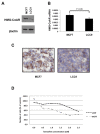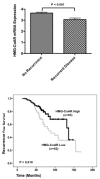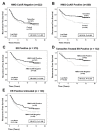Tumor-specific HMG-CoA reductase expression in primary premenopausal breast cancer predicts response to tamoxifen
- PMID: 21281480
- PMCID: PMC3109580
- DOI: 10.1186/bcr2820
Tumor-specific HMG-CoA reductase expression in primary premenopausal breast cancer predicts response to tamoxifen
Abstract
Introduction: We previously reported an association between tumor-specific 3-hydroxy-3-methylglutharyl-coenzyme A reductase (HMG-CoAR) expression and a good prognosis in breast cancer. Here, the predictive value of HMG-CoAR expression in relation to tamoxifen response was examined.
Methods: HMG-CoAR protein and RNA expression was analyzed in a cell line model of tamoxifen resistance using western blotting and PCR. HMG-CoAR mRNA expression was examined in 155 tamoxifen-treated breast tumors obtained from a previously published gene expression study (Cohort I). HMG-CoAR protein expression was examined in 422 stage II premenopausal breast cancer patients, who had previously participated in a randomized control trial comparing 2 years of tamoxifen with no systemic adjuvant treatment (Cohort II). Kaplan-Meier analysis and Cox proportional hazards modeling were used to estimate the risk of recurrence-free survival (RFS) and the effect of HMG-CoAR expression on tamoxifen response.
Results: HMG-CoAR protein and RNA expression were decreased in tamoxifen-resistant MCF7-LCC9 cells compared with their tamoxifen-sensitive parental cell line. HMG-CoAR mRNA expression was decreased in tumors that recurred following tamoxifen treatment (P < 0.001) and was an independent predictor of RFS in Cohort I (hazard ratio = 0.63, P = 0.009). In Cohort II, adjuvant tamoxifen increased RFS in HMG-CoAR-positive tumors (P = 0.008). Multivariate Cox regression analysis demonstrated that HMG-CoAR was an independent predictor of improved RFS in Cohort II (hazard ratio = 0.67, P = 0.010), and subset analysis revealed that this was maintained in estrogen receptor (ER)-positive patients (hazard ratio = 0.65, P = 0.029). Multivariate interaction analysis demonstrated a difference in tamoxifen efficacy relative to HMG-CoAR expression (P = 0.05). Analysis of tamoxifen response revealed that patients with ER-positive/HMG-CoAR tumors had a significant response to tamoxifen (P = 0.010) as well as patients with ER-positive or HMG-CoAR-positive tumors (P = 0.035). Stratification according to ER and HMG-CoAR status demonstrated that ER-positive/HMG-CoAR-positive tumors had an improved RFS compared with ER-positive/HMG-CoAR-negative tumors in the treatment arm (P = 0.033); this effect was lost in the control arm (P = 0.138), however, suggesting that HMG-CoAR predicts tamoxifen response.
Conclusions: HMG-CoAR expression is a predictor of response to tamoxifen in both ER-positive and ER-negative disease. Premenopausal patients with tumors that express ER or HMG-CoAR respond to adjuvant tamoxifen.
Figures





References
-
- Wejde J, Blegen H, Larsson O. Requirement for mevalonate in the control of proliferation of human breast cancer cells. Anticancer Res. 1992;12:317–324. - PubMed
Publication types
MeSH terms
Substances
Grants and funding
LinkOut - more resources
Full Text Sources
Medical
Molecular Biology Databases

